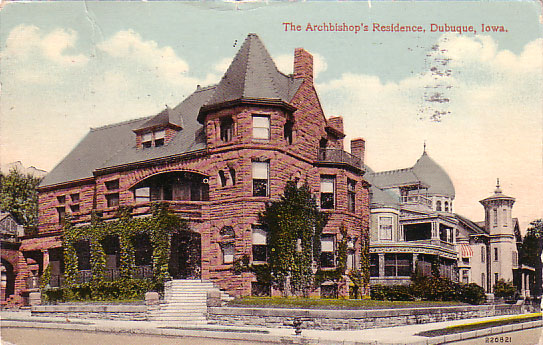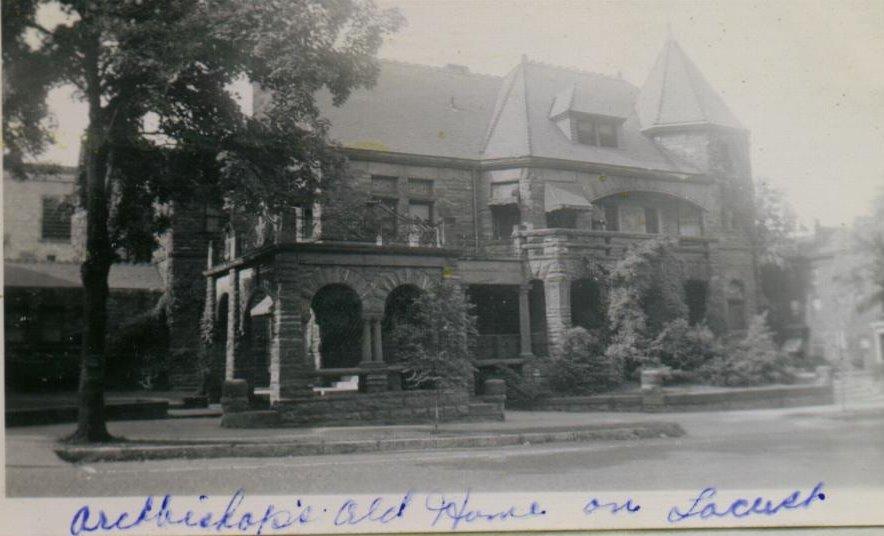Encyclopedia Dubuque
"Encyclopedia Dubuque is the online authority for all things Dubuque, written by the people who know the city best.”
Marshall Cohen—researcher and producer, CNN
Affiliated with the Local History Network of the State Historical Society of Iowa, and the Iowa Museum Association.
STOUT HOUSE: Difference between revisions
No edit summary |
No edit summary |
||
| (23 intermediate revisions by the same user not shown) | |||
| Line 1: | Line 1: | ||
[[Image: | [[Image:stouthouse-2.jpg|left|thumb|250px|]] | ||
[[File:stouth.jpg|250px|thumb|left|c. early 1940s. Photo courtesy: Lou (Hoffmann) Klein and Carol Pfeiler]]STOUT HOUSE. The Stout House is Dubuque's only representative of [[RICHARDSONIAN ROMANESQUE ARCHITECTURE]] in a private home. The mansion, originally belonging to [[STOUT, Frank D.|Frank D. STOUT]], a prominent lumber dealer, was designed by an architect named Spenser. The family moved in around the first of October, 1891. (1) | |||
Stout had especially the first floor of the home detailed with fine woods including maple, rosewood, oak, and mahogany. (2) He used the home as his company's office. Visitors could envision how the different woods Stout sold could be incorporated into their own home--and then purchased the lumber from Stout. (3) The decor of the house included parquet floors, decorative plaster ceilings, a communication device built into the wall from the first to second floor, and stained glass windows. The original bathroom fixtures were of German silver. (4) One of the bathrooms finished in alabaster cost $8,000. (5) The plumbing was said to have cost $30,000. (6) Rarely seen home construction, the home had a stained glass window built into the eastern-most chimney by splitting the flue. | |||
The ideal home of a lumber baron, the design called for each room on the first floor to be paneled in a different wood. Every board was to be dovetailed, meaning that each nail was driven into a place where a splinter of wood had been removed. The splinter was then glued over the nail to disguise it. (7) Upon moving to the red sandstone home, located at 1105 Locust Street, the Stouts donated their former home and land on 9th and Iowa [[STREETS]] to the [[YOUNG MEN'S CHRISTIAN ASSOCIATION (Y.M.C.A.)]]. | |||
With his decision to move to Chicago, Frank Stout sold the mansion to his sister, Evelyn. In 1909 she sold the mansion to [[NAGLE, Joseph J.|Joseph J. NAGLE]] of Dubuque for $25,000 leading to the following statement in the newspaper: | |||
Among judges of Dubuque property it is the unanimous | |||
verdict that this is the most monumental bargain that | |||
ever has been consummated in the city. (8) | |||
The [[ARCHDIOCESE OF DUBUQUE]] owned the home after 1911, when priests bought the house as a gift for Archbishop [[KEANE, James J.|James J. KEANE]]. (9) The following year, the archbishop signed the house over to the archdiocese. (10) While the archbishops lived in the home, a large room on the third floor with light blue carpeting and matching stained glass windows served as a chapel. (11) | |||
Archbishop [[BECKMAN, Francis J.L.|Francis J. L. BECKMAN]] turned the house into an office and purchased a home on Fremont Avenue. (12) Archbishop [[ROHLMAN, Henry P.|Henry P. ROHLMAN]] restored most of the house for living quarters and ordered the construction of an office addition west of the house. (13) | |||
Archbishops lived in the home until the installation of [[KUCERA, Daniel|Daniel KUCERA]] who chose a smaller home on Pennsylvania Avenue. Kucera had referred to the house as a "museum." In an interview in October, 1984, he had stated, "I wouldn't build the house I'm living in, but now that I'm living in it, it's comfortable. You get used to living in museums too." Kucera, a Benedictine monk known for simple living, had sold a similar house when bishop of Salina, Kansas. (14) The Stout House was first offered to [[LORAS COLLEGE]] as a possible museum. Other potential buyers had expressed plans to dismantle part of the house to create meeting rooms, apartments or clubhouses which would have lessened its historic value. (15) | |||
In 1985 the home with its twenty-two rooms and eleven bedrooms was sold to the Dubuque Historic Improvement Company for $215,000. (16) The company announced that it intended to offer a few guest rooms and a restaurant to the public by the start of the 1986 tourist season. A major renovation would not occur for at least one year and would then depend upon [[REDSTONE (THE)]], which the company also owned, being at full occupancy on a regular basis. (17) | |||
The house without its contents was placed on sale in 1994. (18) | |||
In 2008 the Stout House was a private residence. A great amount of external improvements were made including the creation of a brick sidewalk, a new roof, and the addition of old-fashioned street lights. Stones which had suffered weathering at the lower levels of the home were replaced. | |||
--- | |||
Source: | |||
1. "Municipal Molecules," ''Dubuque Daily Herald,'' October 4, 1891, p. 4 | |||
2. Sommer, Lawrence J. '''The Heritage of Dubuque: An Architectural View''', East Dubuque: Tel Graphics, 1975, p. 124-125 | |||
3. Bed-and-breakfast introduction to the home | |||
4. Sommer, Lawrence J. | |||
5. "Joe Nagel Buys Stout Property," ''Telegraph Herald'', Nov. 6, 1909, p. 3. Online: http://news.google.com/newspapers?id=bB9CAAAAIBAJ&sjid=a6oMAAAAIBAJ&pg=3556,690157&dq=stout+house+dubuque&hl=en | |||
6. Ibid. | |||
7. Bed-and-breakfast introduction to the home | |||
8. "Joe Nagel Buys Stout Property..." | |||
9. Nepper, Mark. "Redstone Owners Plan Hotel, Restaurant, For Archdiocese Home," ''Telegraph Herald'', Dec. 19, 1985, p. 2. Online: http://news.google.com/newspapers?id=kMdFAAAAIBAJ&sjid=0ucMAAAAIBAJ&pg=3680,2417505&dq=redstone+dubuque&hl=en | |||
10. Ibid. | |||
11. Johnson, Patt. "Stout House Now Hosts Bed 'N' Breakfast," ''Telegraph Herald'', May 8, 1986, p. 3. Online: http://news.google.com/newspapers?id=QpVdAAAAIBAJ&sjid=rFwNAAAAIBAJ&pg=6536,1195985&dq=stout+house+dubuque&hl=en | |||
12. Gallagher, Mary Kevin. '''Seed/Harvest''', Dubuque, Iowa: Archdiocese of Dubuque Press, 1987, p. 103 | |||
13. Kraske, Steve. "Archbishop Kucera Plans to Sell Romanesque House," ''Telegraph Herald'', August 15, 1985, p. 1. Online: http://news.google.com/newspapers?id=GAtRAAAAIBAJ&sjid=Ld4MAAAAIBAJ&pg=2952,1585937&dq=stout+house+dubuque&hl=en | |||
14. Ibid. | |||
15. Sommers, Lawrence J. | |||
16. Nepper, Mark. | |||
17. Ibid. | |||
18. "Historic House for Sale," ''Telegraph Herald'', May 24, 1994, p. 21. Online: http://news.google.com/newspapers?id=DgxeAAAAIBAJ&sjid=-l8NAAAAIBAJ&pg=2603,6097993&dq=stout+house+dubuque&hl=en | |||
[[Category: Homes]] | |||
[[Category: Buildings]] | [[Category: Buildings]] | ||
[[Category: Landmarks]] | [[Category: Landmarks]] | ||
[[Category: Postcards]] | [[Category: Postcards]] | ||
[[Category: Firsts]] | |||
[[Category: Bed and Breakfast]] | |||
Latest revision as of 23:46, 21 October 2024
STOUT HOUSE. The Stout House is Dubuque's only representative of RICHARDSONIAN ROMANESQUE ARCHITECTURE in a private home. The mansion, originally belonging to Frank D. STOUT, a prominent lumber dealer, was designed by an architect named Spenser. The family moved in around the first of October, 1891. (1)
Stout had especially the first floor of the home detailed with fine woods including maple, rosewood, oak, and mahogany. (2) He used the home as his company's office. Visitors could envision how the different woods Stout sold could be incorporated into their own home--and then purchased the lumber from Stout. (3) The decor of the house included parquet floors, decorative plaster ceilings, a communication device built into the wall from the first to second floor, and stained glass windows. The original bathroom fixtures were of German silver. (4) One of the bathrooms finished in alabaster cost $8,000. (5) The plumbing was said to have cost $30,000. (6) Rarely seen home construction, the home had a stained glass window built into the eastern-most chimney by splitting the flue.
The ideal home of a lumber baron, the design called for each room on the first floor to be paneled in a different wood. Every board was to be dovetailed, meaning that each nail was driven into a place where a splinter of wood had been removed. The splinter was then glued over the nail to disguise it. (7) Upon moving to the red sandstone home, located at 1105 Locust Street, the Stouts donated their former home and land on 9th and Iowa STREETS to the YOUNG MEN'S CHRISTIAN ASSOCIATION (Y.M.C.A.).
With his decision to move to Chicago, Frank Stout sold the mansion to his sister, Evelyn. In 1909 she sold the mansion to Joseph J. NAGLE of Dubuque for $25,000 leading to the following statement in the newspaper:
Among judges of Dubuque property it is the unanimous
verdict that this is the most monumental bargain that
ever has been consummated in the city. (8)
The ARCHDIOCESE OF DUBUQUE owned the home after 1911, when priests bought the house as a gift for Archbishop James J. KEANE. (9) The following year, the archbishop signed the house over to the archdiocese. (10) While the archbishops lived in the home, a large room on the third floor with light blue carpeting and matching stained glass windows served as a chapel. (11)
Archbishop Francis J. L. BECKMAN turned the house into an office and purchased a home on Fremont Avenue. (12) Archbishop Henry P. ROHLMAN restored most of the house for living quarters and ordered the construction of an office addition west of the house. (13)
Archbishops lived in the home until the installation of Daniel KUCERA who chose a smaller home on Pennsylvania Avenue. Kucera had referred to the house as a "museum." In an interview in October, 1984, he had stated, "I wouldn't build the house I'm living in, but now that I'm living in it, it's comfortable. You get used to living in museums too." Kucera, a Benedictine monk known for simple living, had sold a similar house when bishop of Salina, Kansas. (14) The Stout House was first offered to LORAS COLLEGE as a possible museum. Other potential buyers had expressed plans to dismantle part of the house to create meeting rooms, apartments or clubhouses which would have lessened its historic value. (15)
In 1985 the home with its twenty-two rooms and eleven bedrooms was sold to the Dubuque Historic Improvement Company for $215,000. (16) The company announced that it intended to offer a few guest rooms and a restaurant to the public by the start of the 1986 tourist season. A major renovation would not occur for at least one year and would then depend upon REDSTONE (THE), which the company also owned, being at full occupancy on a regular basis. (17)
The house without its contents was placed on sale in 1994. (18)
In 2008 the Stout House was a private residence. A great amount of external improvements were made including the creation of a brick sidewalk, a new roof, and the addition of old-fashioned street lights. Stones which had suffered weathering at the lower levels of the home were replaced.
---
Source:
1. "Municipal Molecules," Dubuque Daily Herald, October 4, 1891, p. 4
2. Sommer, Lawrence J. The Heritage of Dubuque: An Architectural View, East Dubuque: Tel Graphics, 1975, p. 124-125
3. Bed-and-breakfast introduction to the home
4. Sommer, Lawrence J.
5. "Joe Nagel Buys Stout Property," Telegraph Herald, Nov. 6, 1909, p. 3. Online: http://news.google.com/newspapers?id=bB9CAAAAIBAJ&sjid=a6oMAAAAIBAJ&pg=3556,690157&dq=stout+house+dubuque&hl=en
6. Ibid.
7. Bed-and-breakfast introduction to the home
8. "Joe Nagel Buys Stout Property..."
9. Nepper, Mark. "Redstone Owners Plan Hotel, Restaurant, For Archdiocese Home," Telegraph Herald, Dec. 19, 1985, p. 2. Online: http://news.google.com/newspapers?id=kMdFAAAAIBAJ&sjid=0ucMAAAAIBAJ&pg=3680,2417505&dq=redstone+dubuque&hl=en
10. Ibid.
11. Johnson, Patt. "Stout House Now Hosts Bed 'N' Breakfast," Telegraph Herald, May 8, 1986, p. 3. Online: http://news.google.com/newspapers?id=QpVdAAAAIBAJ&sjid=rFwNAAAAIBAJ&pg=6536,1195985&dq=stout+house+dubuque&hl=en
12. Gallagher, Mary Kevin. Seed/Harvest, Dubuque, Iowa: Archdiocese of Dubuque Press, 1987, p. 103
13. Kraske, Steve. "Archbishop Kucera Plans to Sell Romanesque House," Telegraph Herald, August 15, 1985, p. 1. Online: http://news.google.com/newspapers?id=GAtRAAAAIBAJ&sjid=Ld4MAAAAIBAJ&pg=2952,1585937&dq=stout+house+dubuque&hl=en
14. Ibid.
15. Sommers, Lawrence J.
16. Nepper, Mark.
17. Ibid.
18. "Historic House for Sale," Telegraph Herald, May 24, 1994, p. 21. Online: http://news.google.com/newspapers?id=DgxeAAAAIBAJ&sjid=-l8NAAAAIBAJ&pg=2603,6097993&dq=stout+house+dubuque&hl=en



